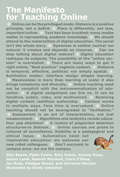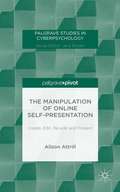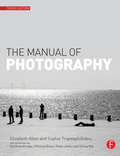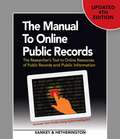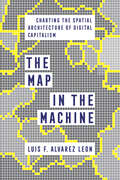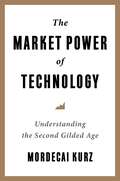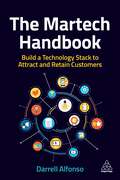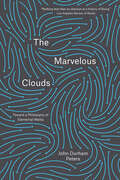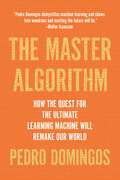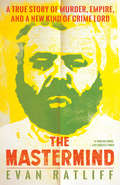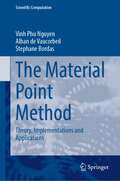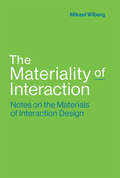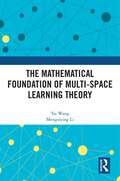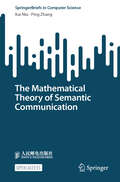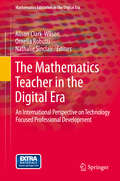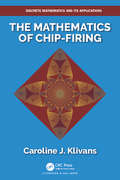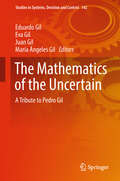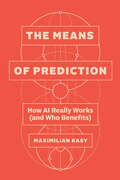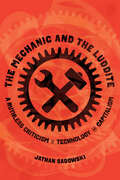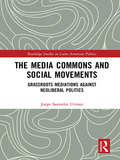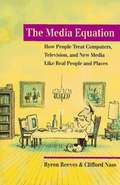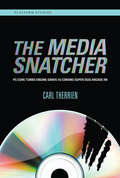- Table View
- List View
The Manifesto for Teaching Online
by Peter Evans Sian Bayne Jeremy Knox Rory Ewins James LambAn update to a provocative manifesto intended to serve as a platform for debate and as a resource and inspiration for those teaching in online environments.In 2011, a group of scholars associated with the Digital Education Centre at the University of Edinburgh released "A Manifesto for Teaching Online," a series of provocative statements intended to articulate their pedagogical philosophy. In the original manifesto and a 2016 update, the authors counter both the "impoverished" vision of education being advanced by corporate and governmental edtech and higher education's traditional view of online students and teachers as second-class citizens. The two versions of the manifesto were much discussed, shared, and debated. In this book, the authors have expanded the text of the 2016 manifesto, revealing the sources and larger arguments behind the abbreviated provocations.
The Manipulation of Online Self-Presentation: Create, Edit, Re-edit and Present
by Alison AttrillThis book explores psychological theories around the ways in which people present themselves online. The role of dispositional and situational factors along with the motivations that drive self-presentation across diverse Internet arenas are considered.
The Manipulators: Facebook, Google, Twitter, and Big Tech's War on Conservatives
by Peter J. HassonFor better or for worse, Google and social media—&“Big Tech,&” collectively—have become the new public square. Unfortunately, this public square has a watchful referee standing behind them, ready and waiting to blow the whistle if they veer too far from the preferred narrative. Americans have given these companies enormous power to select the information they read, share and discuss with their neighbors and friends. We&’ve gotten so used to it, we forget to notice that Big Tech is sifting through the available information and narrowing—and prioritizing—our choices. What happens when that power is weaponized for political ends? Although Big Tech positioned itself initially as providing politically neutral platforms, the truth is that this is no longer the case—far from it. Daily Caller reporter Peter Hasson reveals in The Manipulators that Big Tech is using its huge financial and technological power to severely restrict access to conservative voices and ideas and to rig public debate in favor of America&’s political left wing. This happens in two ways: 1) By censoring and suppressing right-of-center voices and ideas, which restricts access to information that counters the progressive narrative 2) By purposefully amplifying left-wing voices and ideas, which creates the false impression that public consensus lines up with progressive orthodoxy.
The Manual of Photography and Digital Imaging
by Elizabeth Allen Sophie TriantaphillidouThe tenth edition of The Manual of Photography is an indispensable textbook for anyone who is serious about photography. It is ideal if you want to gain insight into the underlying scientific principles of photography and digital imaging, whether you are a professional photographer, lab technician, researcher or student in the field, or simply an enthusiastic amateur. This comprehensive guide takes you from capture to output in both digital and film media, with sections on lens use, darkroom techniques, digital cameras and scanners, image editing techniques and processes, workflow, digital file formats and image archiving. This iconic text was first published in 1890 and has aided many thousands of photographers in developing their own techniques and understanding of the medium. Now in full colour, The Manual of Photography still retains its clear, reader-friendly style and is filled with images and illustrations demonstrating the key principles. Not only giving you the skills and know-how to take stunning photographs, but will also allowing you to fully understand the science behind the creation of great images.
The Manual to Online Public Records: The Researcher's Tool to Online Resources of Public Records and Public Information
by Hetherington Sankey<p>In the 4th edition of The Manual to Online Public Records, authors Sankey and Hetherington shed new light on the mystique of finding public records from government and private sources. The What, Where, and How of online public record access is contained herein on a nationwide basis. <p>Two words epitomize the benefits readers will gain from this completely revised 4th edition: efficiency and accuracy. <p>New chapters explore how to analyze record searching methodology and how to best use social media sites for advanced, creative techniques of finding electronic and paper trails of records. <p>An analysis of 15,000+ government sites is arranged in individual state chapters. Data is presented in a format that is easy-to-use and practical in wording as well as spiked with subjective comments on value and benefits. Readers will soon learn of detailed information on key locations, including data not found from a Google Search. <p>The Manual also provides techniques on how to narrow the overwhelming array of vendors to find those sites that best suit a researcher's needs. <p>More than any of the earlier editions, this resource provides the competitive edge for concise record research.</p>
The Map in the Machine: Charting the Spatial Architecture of Digital Capitalism
by Luis F. Alvarez LeonDigital technologies have changed how we shop, work, play, and communicate, reshaping our societies and economies. To understand digital capitalism, we need to grasp how advances in geospatial technologies underpin the construction, operation, and refinement of markets for digital goods and services. In The Map in the Machine, Luis F. Alvarez Leon examines these advances, from MapQuest and Google Maps to the rise of IP geolocation, ridesharing, and a new Earth Observation satellite ecosystem. He develops a geographical theory of digital capitalism centered on the processes of location, valuation, and marketization to provide a new vantage point from which to better understand, and intervene in, the dominant techno-economic paradigm of our time. By centering the spatiality of digital capitalism, Alvarez Leon shows how this system is the product not of seemingly intangible information clouds but rather of a vast array of technologies, practices, and infrastructures deeply rooted in place, mediated by geography, and open to contestation and change.
The Market Power of Technology: Understanding the Second Gilded Age
by Mordecai KurzSince the 1980s, the United States has regressed to a level of economic inequality not seen since the Gilded Age in the late nineteenth century. At the same time, technological innovation has transformed society, and a core priority of public policy has been promoting innovation. What is the relationship between economic inequality and technological change?Mordecai Kurz develops a comprehensive integrated theory of the dynamics of market power and income inequality. He shows that technological innovations are not simply sources of growth and progress: they sow the seeds of market power. In a free market economy with intellectual property rights, firms’ control over technology enables them to expand, attain monopoly power, and earn exorbitant profits. Competition among innovators does not eliminate market power because technological competition is different from standard competition; it results in only one or two winners. Kurz provides a pioneering analysis grounded on quantifying technological market power and its effects on inequality, innovation, and economic growth. He outlines what causes market power to rise and fall and details its macroeconomic and distributional consequences.Kurz demonstrates that technological market power tends to rise, increasing inequality of income and wealth. Unchecked inequality threatens the foundations of democracy: public policy is the only counterbalancing force that can restrain corporate power, attain more egalitarian distribution of wealth, and make democracy compatible with capitalism. Presenting a new paradigm for understanding today’s vast inequalities, this book offers detailed proposals to redress them by restricting corporate mergers and acquisitions, reforming patent law, improving the balance of power in the labor market, increasing taxation, promoting upward mobility, and stabilizing the middle class.
The Martech Handbook: Build a Technology Stack to Attract and Retain Customers
by Darrell AlfonsoIncrease customer attraction, acquisition and retention by using technology to create seamless, effective and joined-up marketing.It can be hard to know where to begin with the sheer number of platforms and solutions available to marketers today, as well as to use martech to its full potential. The Martech Handbook provides a clear and step-by-step framework for understanding and selecting various forms of marketing technology to drive business value in all areas of marketing, from CX, automation and lead management, to reporting and analysis as well as designing and orchestrating a tech stack that brings them all together.This book also explores getting buy-in, scaling martech within organizations depending on their needs, size and budget as well as measurement, monitoring and governance. Written by an award-winning martech leader, it features case studies and examples from companies including Spotify and Amazon alongside frameworks, question checklists, and interviews with leading industry practitioners. This is an essential resource for augmenting your marketing and achieving key objectives through leveraging technology.
The Marvelous Clouds: Toward a Philosophy of Elemental Media
by John Durham PetersWhen we speak of clouds these days, it is as likely that we mean data clouds or network clouds as cumulus or stratus. In their sharing of the term, both kinds of clouds reveal an essential truth: that the natural world and the technological world are not so distinct. In The Marvelous Clouds, John Durham Peters argues that though we often think of media as environments, the reverse is just as true--environments are media. Peters defines media expansively as elements that compose the human world. Drawing from ideas implicit in media philosophy, Peters argues that media are more than carriers of messages: they are the very infrastructures combining nature and culture that allow human life to thrive. Through an encyclopedic array of examples from the oceans to the skies, The Marvelous Clouds reveals the long prehistory of so-called new media. Digital media, Peters argues, are an extension of early practices tied to the establishment of civilization such as mastering fire, building calendars, reading the stars, creating language, and establishing religions. New media do not take us into uncharted waters, but rather confront us with the deepest and oldest questions of society and ecology: how to manage the relations people have with themselves, others, and the natural world. A wide-ranging meditation on the many means we have employed to cope with the struggles of existence--from navigation to farming, meteorology to Google--The Marvelous Clouds shows how media lie at the very heart of our interactions with the world around us. Peters's book will not only change how we think about media but provide a new appreciation for the day-to-day foundations of life on earth that we so often take for granted.
The Master Algorithm: How the Quest for the Ultimate Learning Machine Will Remake Our World
by Pedro DomingosAlgorithms increasingly run our lives. They find books, movies, jobs, and dates for us, manage our investments, and discover new drugs. More and more, these algorithms work by learning from the trails of data we leave in our newly digital world. Like curious children, they observe us, imitate, and experiment. And in the world’s top research labs and universities, the race is on to invent the ultimate learning algorithm: one capable of discovering any knowledge from data, and doing anything we want, before we even ask. Machine learning is the automation of discovery--the scientific method on steroids--that enables intelligent robots and computers to program themselves. No field of science today is more important yet more shrouded in mystery. Pedro Domingos, one of the field’s leading lights, lifts the veil for the first time to give us a peek inside the learning machines that power Google, Amazon, and your smartphone. He charts a course through machine learning’s five major schools of thought, showing how they turn ideas from neuroscience, evolution, psychology, physics, and statistics into algorithms ready to serve you. Step by step, he assembles a blueprint for the future universal learner--the Master Algorithm--and discusses what it means for you, and for the future of business, science, and society. If data-ism is today’s rising philosophy, this book will be its bible. The quest for universal learning is one of the most significant, fascinating, and revolutionary intellectual developments of all time. A groundbreaking book, The Master Algorithm is the essential guide for anyone and everyone wanting to understand not just how the revolution will happen, but how to be at its forefront.
The Mastermind: Drugs. Empire. Murder. Betrayal.
by Evan RatliffThe incredible true story of the decade-long quest to bring down Paul Le Roux—the creator of a frighteningly powerful Internet-enabled cartel who merged the ruthlessness of a drug lord with the technological savvy of a Silicon Valley entrepreneur“Evan Ratliff has pried open a hidden world of high-tech gangsters and drug kingpins and double-crossers and stone-cold hitmen.”—David Grann, author of Killers of the Flower Moon It all started as an online prescription drug network, supplying hundreds of millions of dollars’ worth of painkillers to American customers. It would not stop there. Before long, the business had turned into a sprawling multinational conglomerate engaged in almost every conceivable aspect of criminal mayhem. Yachts carrying $100 million in cocaine. Safe houses in Hong Kong filled with gold bars. Shipments of methamphetamine from North Korea. Weapons deals with Iran. Mercenary armies in Somalia. Teams of hit men in the Philippines. Encryption programs so advanced that the government could not break them. The man behind it all, pulling the strings from a laptop in Manila, was Paul Calder Le Roux—a reclusive programmer turned criminal genius who could only exist in the networked world of the twenty-first century, and the kind of self-made crime boss that American law enforcement had never imagined. For half a decade, DEA agents played a global game of cat-and-mouse with Le Roux as he left terror and chaos in his wake. Each time they came close, he would slip away. It would take relentless investigative work, and a shocking betrayal from within his organization, to catch him. And when he was finally caught, the story turned again, as Le Roux struck a deal to bring down his own organization and the people he had once employed. Award-winning investigative journalist Evan Ratliff spent four years piecing together this intricate puzzle, chasing Le Roux’s empire and his shadowy henchmen around the world, conducting hundreds of interviews and uncovering thousands of documents. The result is a riveting, unprecedented account of a crime boss built by and for the digital age.Advance praise for The Mastermind“A true crime classic”—Publishers Weekly (starred review) “If truth is stranger than fiction, then The Mastermind is the truest book you’ll read this year. The only thing predictable about it is how quickly you’ll turn the pages.”—Noah Hawley, author of Before the Fall and creator of the TV series Fargo
The Material Point Method: Theory, Implementations and Applications (Scientific Computation)
by Vinh Phu Nguyen Alban de Vaucorbeil Stephane BordasThis book provides an introduction to the fundamental theory, practical implementation, and core and emerging applications of the material point method (MPM) and its variants. The MPM combines the advantages of both finite element analysis (FEM) and meshless/meshfree methods (MMs) by representing the material by a set of particles overlaid on a background mesh that serves as a computational scratchpad.The book shows how MPM allows a robust, accurate, and efficient simulation of a wide variety of material behaviors without requiring overly complex implementations. MPM and its variants have been shown to be successful in simulating a large number of high deformation and complicated engineering problems such as densification of foam, sea ice dynamics, landslides, and energetic device explosions, to name a few, and have recently found applications in the movie industry. It is hoped that this comprehensive exposition on MPM variants and their applications will not only provide an opportunity to re-examine previous contributions, but also to re-organize them in a coherent fashion and in anticipation of new advances.Sample algorithms for the solutions of benchmark problems are provided online so that researchers and graduate students can modify these algorithms and develop their own solution algorithms for specific problems. The goal of this book is to provide students and researchers with a theoretical and practical knowledge of the material point method to analyze engineering problems, and it may help initiate and promote further in-depth studies on the subjects discussed.
The Materiality of Interaction: Notes on the Materials of Interaction Design (The\mit Press Ser.)
by Mikael WibergA new approach to interaction design that moves beyond representation and metaphor to focus on the material manifestations of interaction.Smart watches, smart cars, the Internet of things, 3D printing: all signal a trend toward combining digital and analog materials in design. Interaction with these new hybrid forms is increasingly mediated through physical materials, and therefore interaction design is increasingly a material concern. In this book, Mikael Wiberg describes the shift in interaction design toward material interactions. He argues that the “material turn” in human-computer interaction has moved beyond a representation-driven paradigm, and he proposes “material-centered interaction design” as a new approach to interaction design and its materials. He calls for interaction design to abandon its narrow focus on what the computer can do and embrace a broader view of interaction design as a practice of imagining and designing interaction through material manifestations. A material-centered approach to interaction design enables a fundamental design method for working across digital, physical, and even immaterial materials in interaction design projects.Wiberg looks at the history of material configurations in computing and traces the shift from metaphors in the design of graphical user interfaces to materiality in tangible user interfaces. He examines interaction through a material lens; suggests a new method and foundation for interaction design that accepts the digital as a design material and focuses on interaction itself as the form being designed; considers design across substrates; introduces the idea of “interactive compositions”; and argues that the focus on materiality transcends any distinction between the physical and digital.
The Mathematical Foundation of Multi-Space Learning Theory
by Tai Wang Mengsiying LiThis book explores the measurement of learning effectiveness and the optimization of knowledge retention by modeling the learning process and building the mathematical foundation of multi-space learning theory.Multi-space learning is defined in this book as a micro-process of human learning that can take place in more than one space, with the goal of effective learning and knowledge retention. This book models the learning process as a temporal sequence of concept learning, drawing on established principles and empirical evidence. It also introduces the matroid to strengthen the mathematical foundation of multi-space learning theory and applies the theory to vocabulary and mathematics learning, respectively. The results show that, for vocabulary learning, the method can be used to estimate the effectiveness of a single learning strategy, to detect the mutual interference that might exist between learning strategies, and to predict the optimal combination of strategies. In mathematical learning, it was found that timing is crucial in both first learning and second learning in scheduling optimization to maximize the intersection effective interval.The title will be of interest to researchers and students in a wide range of areas, including educational technology, learning sciences, mathematical applications, and mathematical psychology.
The Mathematical Theory of Semantic Communication (SpringerBriefs in Computer Science)
by Ping Zhang Kai NiuThis Open Access Book explores how classical information theory&’s focus on syntactic information has limited the further development of communication science. Recently, communication technologies that handle and transmit semantic information have gained widespread attention in academia. Semantic communication has paved new directions for the future of communication technology development, yet it lacks a general mathematical guiding theory. To address this challenge, this open access book constructs a theoretical framework for semantic information theory and provides a systematic exposition of the measurement system for semantic information and the theoretical limits of semantic communication. It serves as a professional reference for researchers in information and communication. The book begins by deeply analyzing the data characteristics of various information sources and the needs of downstream tasks to summarize and generalize the universal attribute of semantic information—synonymity and to define the synonymous mapping between semantic information and syntactic information. Stemming from this core concept, synonymous mapping, this book introduces the measures of semantic information. It then introduces a new mathematical tool, Synonymous Asymptotic Equipartition (AEP), to explore the mathematical properties of synonymous typical sequences and applies random coding and synonymous typical sequence decoding/encoding to prove the semantic lossless source coding theorem, semantic channel coding theorem, and semantic limited distortion source coding theorem. In addition, the semantic information measures in the continuous case are discussed and a new channel capacity formula of the band-limited Gaussian channel is obtained, which is an important extension of the classical channel capacity. The book is a valuable resource for researchers, academics, and professionals in the field of information and communication, particularly those interested in advancing the frontiers of semantic communication technology.
The Mathematical Tourist: New and Updated Snapshots of Modern Mathematics
by Ivars PetersonTo most outsiders, modern mathematics represents unknown territory. Few realize that the world of modern mathematics is rich with vivid images, provocative ideas, and useful notions. The revised, updated book also includes new material about the structure of crystals and about discoveries illuminating the relationship between four-dimensional geometry and physical theories of the nature of time, space, and matter. It adds the application of cellular automata models to social questions and to the peregrinations of virtual ants. It extends the discussion of applications of fractals and introduces the notion of controlling chaos. A greatly expanded concluding chapter on the nature of mathematical proof includes accounts of Turing machines, transparent proofs, and how a computer program managed to prove a long-standing mathematical conjecture. It ends with the dramatic unveiling of a proof by Andrew Wiles of Fermat's last theorem.
The Mathematics Teacher in the Digital Era: An International Perspective on Technology Focused Professional Development (Mathematics Education in the Digital Era #2)
by Nathalie Sinclair Alison Clark-Wilson Ornella RobuttiThis volume addresses the key issue of the initial education and lifelong professional learning of teachers of mathematics to enable them to realize the affordances of educational technology for mathematics. With invited contributions from leading scholars in the field, this volume contains a blend of research articles and descriptive texts.In the opening chapter John Mason invites the reader to engage in a number of mathematics tasks that highlight important features of technology-mediated mathematical activity. This is followed by three main sections:An overview of current practices in teachers’ use of digital technologies in the classroom and explorations of the possibilities for developing more effective practices drawing on a range of research perspectives (including grounded theory, enactivism and Valsiner’s zone theory).A set of chapters that share many common constructs (such as instrumental orchestration, instrumental distance and double instrumental genesis) and research settings that have emerged from the French research community, but have also been taken up by other colleagues.Meta-level considerations of research in the domain by contrasting different approaches and proposing connecting or uniting elements
The Mathematics of Chip-Firing (Discrete Mathematics and Its Applications)
by Caroline J. KlivansThe Mathematics of Chip-firing is a solid introduction and overview of the growing field of chip-firing. It offers an appreciation for the richness and diversity of the subject. Chip-firing refers to a discrete dynamical system — a commodity is exchanged between sites of a network according to very simple local rules. Although governed by local rules, the long-term global behavior of the system reveals fascinating properties. The Fundamental properties of chip-firing are covered from a variety of perspectives. This gives the reader both a broad context of the field and concrete entry points from different backgrounds. Broken into two sections, the first examines the fundamentals of chip-firing, while the second half presents more general frameworks for chip-firing. Instructors and students will discover that this book provides a comprehensive background to approaching original sources. Features: Provides a broad introduction for researchers interested in the subject of chip-firing The text includes historical and current perspectives Exercises included at the end of each chapter About the Author: Caroline J. Klivans received a BA degree in mathematics from Cornell University and a PhD in applied mathematics from MIT. Currently, she is an Associate Professor in the Division of Applied Mathematics at Brown University. She is also an Associate Director of ICERM (Institute for Computational and Experimental Research in Mathematics). Before coming to Brown she held positions at MSRI, Cornell and the University of Chicago. Her research is in algebraic, geometric and topological combinatorics.
The Mathematics of the Uncertain: A Tribute To Pedro Gil (Studies In Systems, Decision And Control #142)
by María Ángeles Gil Eduardo Gil Eva Gil Juan GilThis book is a tribute to Professor Pedro Gil, who created the Department of Statistics, OR and TM at the University of Oviedo, and a former President of the Spanish Society of Statistics and OR (SEIO). In more than eighty original contributions, it illustrates the extent to which Mathematics can help manage uncertainty, a factor that is inherent to real life. Today it goes without saying that, in order to model experiments and systems and to analyze related outcomes and data, it is necessary to consider formal ideas and develop scientific approaches and techniques for dealing with uncertainty. Mathematics is crucial in this endeavor, as this book demonstrates. As Professor Pedro Gil highlighted twenty years ago, there are several well-known mathematical branches for this purpose, including Mathematics of chance (Probability and Statistics),Mathematics of communication (Information Theory), andMathematics of imprecision (Fuzzy Sets Theory and others).These branches often intertwine, since different sources of uncertainty can coexist, and they are not exhaustive. While most of the papers presented here address the three aforementioned fields, some hail from other Mathematical disciplines such as Operations Research; others, in turn, put the spotlight on real-world studies and applications. The intended audience of this book is mainly statisticians, mathematicians and computer scientists, but practitioners in these areas will certainly also find the book a very interesting read.
The Means of Prediction: How AI Really Works (and Who Benefits)
by Maximilian KasyAn eye-opening examination of how power—not technology—will define life with AI. AI is inescapable, from its mundane uses online to its increasingly consequential decision-making in courtrooms, job interviews, and wars. The ubiquity of AI is so great that it might produce public resignation—a sense that the technology is our shared fate. As economist Maximilian Kasy shows in The Means of Prediction, artificial intelligence, far from being an unstoppable force, is irrevocably shaped by human decisions—choices made to date by the ownership class that steers its development and deployment. Kasy shows that the technology of AI is ultimately not that complex. It is insidious, however, in its capacity to steer results to its owners’ wants and ends. Kasy clearly and accessibly explains the fundamental principles on which AI works, and, in doing so, reveals that the real conflict isn’t between humans and machines, but between those who control the machines and the rest of us. The Means of Prediction offers a powerful vision of the future of AI: a future not shaped by technology, but by the technology’s owners. Amid a deluge of debates about technical details, new possibilities, and social problems, Kasy cuts to the core issue: Who controls AI’s objectives, and how is this control maintained? The answer lies in what he calls “the means of prediction,” or the essential resources required for building AI systems: data, computing power, expertise, and energy. As Kasy shows, in a world already defined by inequality, one of humanity’s most consequential technologies has been and will be steered by those already in power. Against those stakes, Kasy offers an elegant framework both for understanding AI’s capabilities and for designing its public control. He makes a compelling case for democratic control over AI objectives as the answer to mounting concerns about AI's risks and harms. The Means of Prediction is a revelation, both an expert undressing of a technology that has masqueraded as more complicated and a compelling call for public oversight of this transformative technology.
The Measure of All Minds
by José Hernández-OralloAre psychometric tests valid for a new reality of artificial intelligence systems, technology-enhanced humans, and hybrids yet to come? Are the Turing Test, the ubiquitous CAPTCHAs, and the various animal cognition tests the best alternatives? In this fascinating and provocative book, José Hernández-Orallo formulates major scientific questions, integrates the most significant research developments, and offers a vision of the universal evaluation of cognition. By replacing the dominant anthropocentric stance with a universal perspective where living organisms are considered as a special case, long-standing questions in the evaluation of behavior can be addressed in a wider landscape. Can we derive task difficulty intrinsically? Is a universal g factor - a common general component for all abilities - theoretically possible? Using algorithmic information theory as a foundation, the book elaborates on the evaluation of perceptual, developmental, social, verbal and collective features and critically analyzes what the future of intelligence might look like. Provides a universal framework integrating the evaluation of development, social and communication skills, and collective intelligence Compares the behavior evaluation of humans, non-human animals, and computers Blends cutting-edge theory and technology with historical context
The Mechanic and the Luddite: A Ruthless Criticism of Technology and Capitalism
by Dr. Jathan SadowskiThis short book demystifies how the two systems of technology and capitalism work together and equips readers with practical tools to dismantle them and build a better world, bit by bit. Our society is constantly made to serve the needs of two systems: technology and capitalism. Neither exists outside humans, but both are treated as above and beyond us. The Mechanic and the Luddite offers the critical tools needed to deconstruct these systems—how they work, whom they work for, and what work they do in our lives. With signature style and energy, Jathan Sadowski presents a provocative one-stop shop for understanding the political economy of technology and capitalism. Each chapter breaks down key features of technological capitalism, offering sharp, synthetic, and authoritative analysis of topics like innovation, labor, data, and risk. It's not enough to know how the machinery of capitalism is put together and how its parts operate; we must also know whom the machines serve and when they should be taken apart, to be rebuilt for new purposes or destroyed for good. The Mechanic and the Luddite provides the political guidance needed to make these crucial decisions.
The Media Commons and Social Movements: Grassroots Mediations Against Neoliberal Politics (Routledge Studies in Latin American Politics)
by Jorge Saavedra UtmanWhat does it mean to have a voice in a formal democracy operating under neoliberal guidelines and with an almost entirely private media system? How can the people gain their voice and engage in a dialogue with hegemonic actors and discourses? In this book, Jorge Saavedra Utman examines the role of media and communicative practices during one of the largest social mobilizations in Latin America in the last 30 years: Chile’s 2011 students’ movement. Saavedra Utman observes the eye-catching, subversive, but also intimate practices that, in a country with a liberal democracy and neoliberal policies, allowed people to speak up and become political actors from grassroots positions. Presenting rich qualitative data that is sourced from interviews and focus groups with activists, he introduces a fresh perspective on the study of media and communications and social movements. Saavedra Utman paints a clearer picture of contentious events since 2011 - like the Arab Spring and Occupy – to understand the relevance of media and communications in contemporary quests for participation and democracy. Promising to be an important book, The Media Commons and Social Movements represents a significant contribution to our understanding of communicative dimensions of protest and social change.
The Media Equation: How People Treat Computers, Televisions, and New Media Like Real People and Places
by Byron Reeves Clifford NassAccording to popular wisdom, humans never relate to a computer or a television program in the same way they relate to another human being. Or do they? The psychological and sociological complexities of the relationship could be greater than you think. In an extraordinary revision of received wisdom, Byron Reeves and Clifford Nass demonstrate convincingly in The Media Equation that interactions with computers, television, and new communication technologies are identical to real social relationships and to the navigation of real physical spaces. Using everyday language, the authors explain their novel ideas in a way that will engage general readers with an interest in cutting-edge research at the intersection of psychology, communication and computer technology. The result is an accessible summary of exciting ideas for modern times. As Bill Gates says, '(they) ... have shown us some amazing things'.
The Media Snatcher: PC/CORE/TURBO/ENGINE/GRAFX/16/CDROM2/SUPER/DUO/ARCADE/RX (Platform Studies)
by Carl TherrienAn in-depth exploration of a neglected video game platform of the 1990s and a reflection on the way we construct the cultural history of video games.In The Media Snatcher, Carl Therrien offers an in-depth exploration of NEC's PC Engine/TurboGrafx-16, a little-studied video game platform released in the late 1980s. The PC Engine was designed to bring technological expandability to the world of game consoles; The Media Snatcher's subtitle evokes some of the expansions and the numerous rebranded versions of the system released by NEC, including the first CD-ROM add-on in video game history. The platform makers hoped that expandability would allow its console to remain at the cutting edge and even catch up with such perceptually rich media as cinema and anime. More than a simple shape-shifter, the PC Engine became a media snatcher.Therrien examines the multidirectional interactions of video game technologies, commercial structures, and cultural dynamics. He considers, among other things, hyperbolic marketing and its impact on how we construct video game history; glitches, technological obsolescence, and the difficulty of conducting media archaeology of the recent past; the emergence of male-centered power fantasies through audiovisual rewards; the rise of original genres such as visual novels; and the sustained efforts to integrate PC Engine software in the sprawling media landscape of Japan (where the PC Engine found much of its success). Avoiding the usual techno-industrial glorification, Therrien recounts the bold technological aspirations of the platform makers and the struggles to make the actual technology realize its potential.
